Definitions
- Zooplankton = all heterotrophic plankton except bacteria and viruses; size range from 2 µm (heterotrophic flagellates, protists) up to several meter (jellyfish)
- Nutritional modes in zooplankton:
- Herbivores: feed primarily on phytoplankton
- Carnivores: feed primarily on other zooplankton (animals)
- Detrivores: feed primarily on dead organic matter (detritus)
- Omnivores: feed on mixed diet of plants and animals and detritus
- Zooplankton can be categorized by size (see fig. 1.2, page 4 textbook)
- Zooplankton can be categorized by their life cycle:
- Holoplankton: spend entire life in the water column (pelagial)
- Meroplankton: spend only part of their life in the pelagial, mostly larval forms of invertebrates and fish
- Ichthyoplankton: fish eggs and fish larvae
- Dinoflagellates: heterotrophic relatives to the phototrophic Dinophyceae; naked and thecate forms. Noctiluca miliaris – up to 1 mm or bigger, bioluminescence, prey on fish egg & zooplankton
- Zooflagellates = heterotrophic nanoflagellates (HNF): taxonomically mixed group of small, naked flagellates, feed on bacteria and small phytoplankton; choanoflagellates: collar around flagella
- Foraminifera: relatives of amoeba with calcareous shell, which is composed of a series of chambers; contribute to ooze sediments; 30 µm to 1-2 mm, bacteriovores; most abundant 40°N – 40°S
- Radiolaria: spherical, amoeboid cells with silica capsule; 50 µm to several mm; contribute to silica ooze sediments, feed on bacteria, small phyto- and zooplankton; cold water and deep-sea
- Ciliates: feed on bacteria, phytoplankton, HNF; naked forms more abundant but hard to study (delicate!); tintinnids: sub-group of ciliates with vase-like external shell made of protein; herbivores

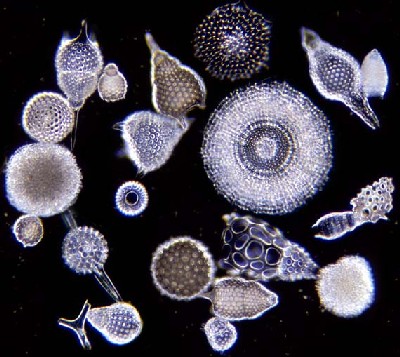
Forms
of radiolarians
- Cnidaria: primitiv group of metazoans; some holoplanktonic, others have benthis stages; carnivorous (crustaceans, fish); long tentacles carry nematocysts used to inject venoms into prey; box jellyfish of Australia kills humans within minutes
- Medusae: single organisms, few mm to several meters
- Siphonophores: colonies of animals with specialization: feeding polyps, reproductive polyps, swimming polyps; Physalia physalis (Protuguese man-of-war), common in tropical waters, Gulf of Mexico, drifted by the wind and belong to the pleuston (live on top of water surface)
- Ctenophores: separate phylum, do not belong to Cnidaria; transparent organisms, swimm with fused cilia; no nematocysts; prey on zooplankton, fish eggs, sometimes small fish; important to fisheries due to grazing on fish eggs and competition for fish food
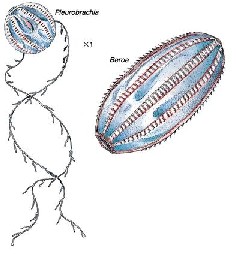
- Chaetognaths: arrow worms, carnivorous, <4 cm
- Polychaets: Tomopteris spp. only important planktonic genus
- Mollusca:
- Heteropods: small group of pelagic relatives of snails, snail food developed into a single “fin”; good eyes, visual predators
- Pteropods: snail foot developed into paired “wings”; suspension feeder – produce large mucous nets to capture prey; carbonate shells produce pteropod ooze on sea floor
- Appendicularia (older: Larvacea): group of Chordata, live in gelatinous balloons (house) that are periodically abandoned; empty houses provide valuable carbon source for bacteria and help to form marine snow; filter feeders of nanoplankton
- Salps: group of Chordata, mostly warm water; typically barrel-form, filter feeders; occur in swarms, which can wipe the water clean of nanoplankton; large fecal bands, transport of nano- and picoplankton to deep-sea; single or colonies
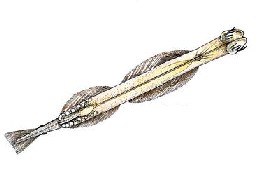
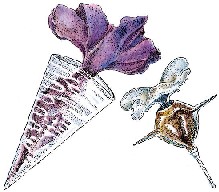
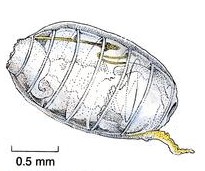
- Cladocera (water fleas): six marine species (Podon spp., Evadne spp.), one brackish water species in the Baltic Sea; fast reproduction by parthenogenesis (without males and egg fertilization) and pedogenesis (young embryos initiate parthenogenetic reproduction before hatching)
- Ostracoda: bivalved shell, usually not important; some species in tropical waters cause bioluminescence; little studied
- Amphipoda: less abundant in pelagial, common genus Themisto; frequently on siphonophores, medusae, ctenophores, salps
- Euphausiida: krill; 15-100 mm, pronounced vertical migration; not plankton sensu strictu; visual predators, fast swimmers, often undersampled because they escape plankton nets; important as prey for commercial fish (herring, mackerel, salmon, tuna) and whales (Antarctica)
- Copepoda most abundant zooplankton in the oceans, “insects of the sea“; herbivorous, carnivorous and omnivorous species;
- Calanoida: most of marine planktonic species
- Cyclopoida: most of freshwater planktonic species
- Harpacticoida: mostly benthic/near-bottom species
- Copepod development: first six larval stages = nauplius (pl. nauplii), followed by six copepodit stages (CI to CVI)
- Tropical species distinct by their long antennae and setae on antennae and legs (podi)
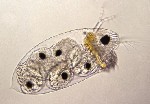 Evadne female with parthenogenetic
young in her brood sack. Youngs can already have developed embryos in their
brook sack (pedogenesis)
Evadne female with parthenogenetic
young in her brood sack. Youngs can already have developed embryos in their
brook sack (pedogenesis)


 Copepod nauplius
Copepod nauplius
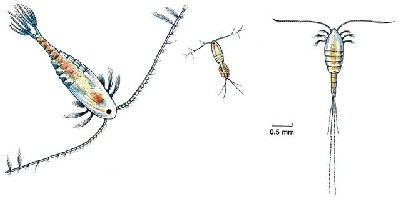
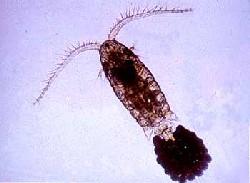
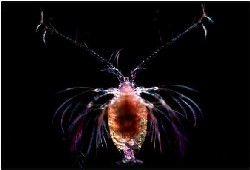
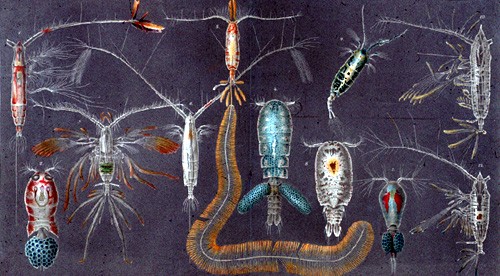
Meroplankton - Larvae of benthic animals
- Mollusca: clams and snails produce shelled veliger larvae; ciliated velum serves for locomotion and food collection
- Cirripedia: barnacles produce nauplii, which turn to cypris
- Echinodermata: sea urchins, starfish and sea cucumber produce pluteus larvae of different shapes, which turn into brachiolaria larvae (starfish); metamorphosis to adult is very complex
- Polychaeta: brittle worms and other worms produce trochophora larvae, mostly barrel- shaped with several bands of cilia
- Decapoda: shrimps and crabs produce zoëa larvae; they turn into megalopa larvae in crabs before settling to the sea floor
- Various other forms of larvae occur in the plankton
- Pisces: fish eggs and larvae referred to as ichthyoplankton; fish larvae retain part of the egg yolk in a sack below their body until mouth and stomach are fully developed
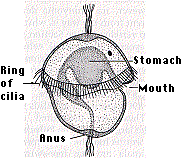
- The Radiolaria home page
- Foraminifera photo resource
- another formainifera web article
- The jellyfish resource
- interactive morphology of copepods
- another good source on copepods /w photos
- Protist databates of the University of Montreal
- Image Quest 3D with wonderful photographs
- SUNY Marine Plankton Images
- The Virtual Copepod Page
- PORTRAYING MICRO ORGANISMS
- A look into freshwater ponds, photos and videos
- Video streams online of various marine plankton